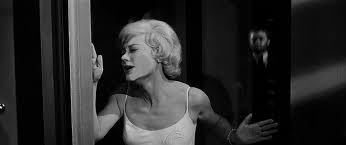Ever since I coined the term ‘enlightened horror’ three seconds ago there has been, I expect, a massive reaction on the internet, most of it negative (‘Enlightened horror? – enfeebled horror more like!’) and I can quite understand. The idea of a form of horror that moves to resolve its own murky neuroses and let the light shine in is bound to meet with resistance, and ought perhaps to come with a health warning – that is, a warning about the viewer’s possible exposure to… health.
And the awkward question arises – if we were healthy, would we watch horror films at all? On the other hand, if we were really healthy, would we be watching anything? Wouldn’t we all be outside making the world a better place? Or at least playing tennis.
Where that leaves the notion of ‘enlightened horror’ I’m not quite sure, and in fact the notion was already being subverted in 1962, nearly six decades before I coined the term a few seconds ago. Time moves fast these days. Or is it slow? Or is it not at all?
Anyway. The Cabinet of Caligari was written by Robert Bloch, best known as the author of Psycho but as Joseph Stefano adapted that for the 1960 film, this is his first venture into scriptwriting, and probably his strangest.
Rather than presenting a remake of the silent original this takes from it not much more than the final twist, that all of the events (SPOILER ALERT) have been the hallucination of a ‘mad’ protagonist in an asylum. Here, however, it’s pretty clear from the off that our protagonist Jane (Glynis Johns) is, as critic Ed Naha put it in his book Horrors From Screen to Scream, ‘not playing with a full deck’.
Having suffered a breakdown (of her sports car, ostensibly) she takes refuge in a mansion over which the sinister Caligari (Dan O’Herlihy) presides, face always in shadow. Apparently keeping her prisoner, Caligari proceeds to subject her to a barrage of odd questions (‘If you had a son, what would he look like?’) in his office, which for some reason has a revolving door. Jane is overwrought throughout, as is her dialogue (‘If the sunshine ever struck you, I believe you’d writhe‘, she tells her tormentor at one point).
Something is obviously awry with the situation – in fact, the film holds to the fiction of the innocent heroine held against her will by the demonic Caligari about as successfully as she does, which is to say not well at all. This makes it an intriguingly unreal viewing experience, like a low-rent Last Year In Marienbad – though arguably this has dated better, or at any rate it doesn’t remind you of a perfume ad.
Throughout we seem to see the real situation – in which Jane is being treated for some kind of mental disorder in Caligari’s upmarket institution – overlaid on the imaginary one, in which an increasingly hysterical heroine witnesses an elderly resident being beaten and is menaced by a dog in a maze. Though Caligari also seems to have a more genial alter ego, also played by O’Herlihy, face unshadowed and Irish accent intact, he is largely a menacing figure, spying on Johns in her bath (‘My bath’, as he puts it) and questioning her about sexual matters in a voyeuristic way.
While this may be just about the patient projecting her fears onto the analyst, the ambiguity of the situation opens up other possibilities: a suggestion of something manipulative and misogynistic at the heart of psychoanalysis itself. It is hardly likely that Robert Bloch was consciously attempting a feminist critique here but unconsciously – who knows? At the end, Jane’s ‘cure’ involves her stripping off in front of Caligari, while exulting in her sexuality.
And yet, young and glamorous at the start of the film, Jane looks middle-aged and drab at the end, and clearly has not been made radiantly happy by her ‘cure’. The lover she was flirting with earlier on now reappears as her irritable son, a slightly different take on that relationship than the one featured in Psycho. We never really know the nature of Jane’s disorder but it looks a bit like a mid-life crisis – a male one, imposed by Bloch onto his heroine (the sports car at the beginning is a dead giveaway).
Roger Kay’s direction, generally stylish, finishes up with an intriguing visual flourish, adopting the cured Jane’s POV as she approaches a mirror to rediscover her ‘true’ sensibly-dressed self. This turns the psychoanalytic process on its head. We would expect to move from a subjective, distorted view to an objective one, but the opposite is the case – the subjective is presented as objective, and the cure only traps us inside the heroine’s mind.
This is probably emotionally true to the experience of a psychoanalytic cure in that it is said to replace the dramatic ups and downs of the disorder with a comparatively dull even keel, but it raises the question of whether the real horror might lie in the cure rather than the ‘disease’. Thus it seems that my notion of ‘enlightened horror’ was retrospectively undermined from the very beginning. So just pretend I never said it.


Recent Comments